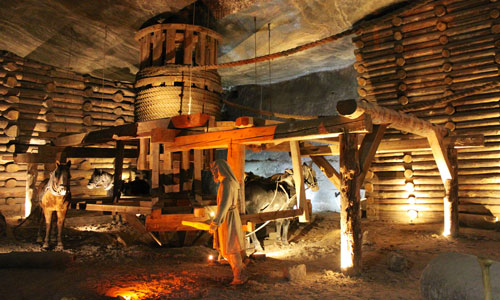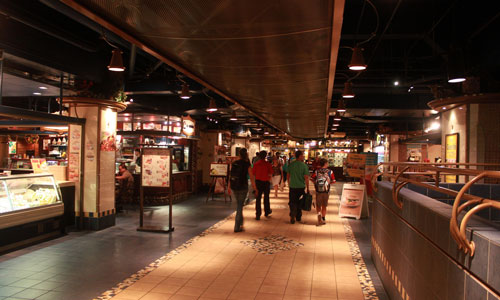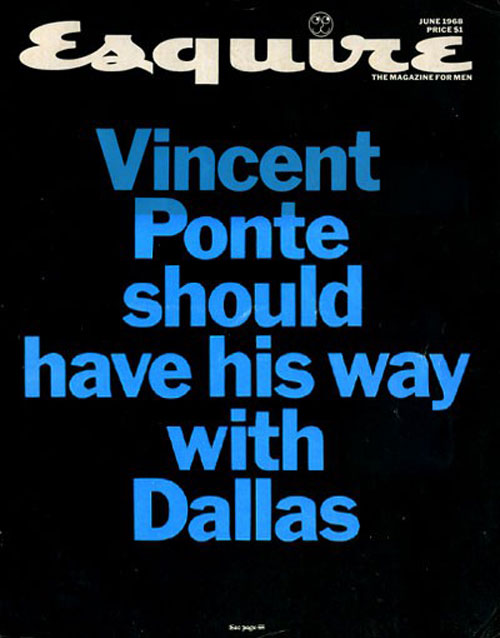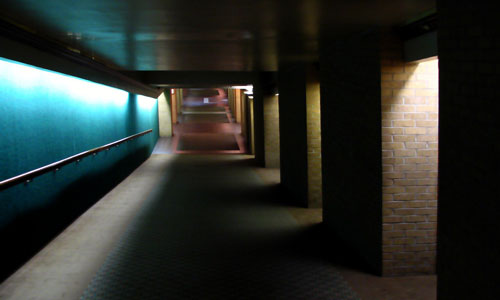We Could Be Happy Underground
Large, below-the-surface underground cities are far from a new phenomenon, but big cities are feeling squeamish about adding or expanding them. Here's why.
5,000
The estimated age, in years, of an underground city found in Nevşehir, Turkey back in 2013. The city is fairly huge, with approximately 3.5 miles of tunnels, and dozens of rooms making up churches, tombs, and other safe spaces. It's not the first ancient underground city found in Turkey's Cappadocia region—people have been finding them since the '60s—but it's the largest, by far. (Well, for now, that is.)

(Alexander Johmann/Flickr)
Five things ancient underground cities have in common with modern ones
- Use as shelter from outside dangers: Modern underground cities are great ways to avoid being stuck in the severe cold or in the rain during a bout of severe weather. Ancient underground cities, like those in the Cappadocia region of Turkey, also served as a way to avoid outside dangers—but in their case, the outside dangers involved religious persecution, as the region made up some early Christians.
- Areas to display artwork: The ancient catacombs of Rome have become noteworthy for their examples of early Christian art, but not to be outdone, Virginia's Crystal City, outside of the Washington, DC area, has become a hub of underground art.
- Consistent temperatures: One of the biggest benefits of an underground city in the modern day is that you probably won't be shocked by the temperature. It'll probably stay at a happy medium between hot and cold. Likewise, the caves in Turkey's Cappadocia region are known for keeping a consistently cool temperature—55.4° F, slightly nippier than your standard underground setting but perfect for storing fruit, as it turns out.
- A potential economic driver: For hundreds of years, Poland's Wieliczka Salt Mine represented the potential that an underground locale could have on an economy. The mine, which dates back to the thirteenth century, became incredibly important from a financial perspective due to salt's growing necessity in food. (It was still dishing out salt until 2007, shockingly.) And it became one of the world's first major underground tourist attractions, with chapels, dining halls, hotels, and other attractions making way after much of the salt was cleared. Ultimately, when an underground city is created today, this kind of economic success is the goal of the whole operation.
- You can book a room: Most planned underground cities are associated with hotels, due to the fact that such hotels are common near downtowns. Since the discovery of the ancient caves in Turkey's Cappadocia region 50 years ago, parts of the caves have been converted to hotels as well. (Prices aren't bad, either; you can get a high-end room at the Cappadocia Cave Suites hotel for $150 a night.)

(Alexander Glintschert/Flickr)
The growth of the modern underground city was an attempt to make urban areas warmer and less scary
" Business cannot abandon downtown. Power, money and enterprise are concentrated there. Downtown is where the action is."
These are the words of Vincent Ponte, an urban planner associated with the modernization of underground cities around North America in the 1960s and 1970s. He made the argument to our greatest urban newspaper, The New York Times, and there was a great need for those words during the time when the suburbs had sucked in numerous families, worried about the declining urban area. He had a lot of success spreading his overall philosophy during an era where the car had clearly won.
His solution to the problem of making cities walkable again and avoiding all that crime and traffic that was scaring off the public? Well, that involved creating an area where it was impossible to bring a car. Ponte's greatest victory as an urban planner was in perhaps the most unique major city in North America, the French-speaking Montreal, a city that Ponte made his adopted hometown.
The ambitious rethinking of Montreal as a partly-underground city made a lot of sense for a number of reasons—particularly the fact that Montreal is a very cold spot to be in the winter. A similarly cold place to be, Minneapolis, created a similar solution to this problem with its above-ground skyway system.
Ponte was seen as a visionary at the time for his approach, which put cars on the surface, pedestrians directly below the ground, and public transit a level below that. Part of the reason for that was that he wanted to protect the value of the downtown, which was facing decay due to the increasing popularity of cars and the perception of blight in urban areas.
"You can't realistically solve the problem by widening streets or banning cars," Ponte told Time Magazine in 1970. "You have to adjust, reshuffle things and separate the trucks, cars and people, each on a distinct level. Back in the 16th century, Leonardo da Vinci sketched plans to separate traffic this way. Rockefeller Center tried it in the 1930s."
Ponte started small, taking advantage of a major building project in the early 1960s, Place Ville-Marie, to test some of his urban design experiments. This created one of the main hubs of the underground city, an urban shopping center. And from there, with Expo 67—a major world's fair in Montreal—bringing loads of investment to the region, the city had just the financial backing to pull it off. And pull it off they did.
Nowadays, Montreal's underground tunnels are a total of 20 miles long, and take up 41 city blocks. That makes it the largest such system in the world. His success in formulating this idea was hard to ignore.

Soon, Ponte's success in Montreal inspired growth elsewhere. In Dallas, he was soon making a pitch for a similar urban upheaval, with his concept eventually spreading through thirty-six city blocks. A 1968 cover of Esquire, targeted at the the southwest, loudly proclaimed that "Vincent Ponte should have his way with Dallas." Ponte's vision, while controversial for some, was the kind of thing that got other folks excited.
He felt that the basic concept could be translated to nearly every large city.
"Everybody benefits," Ponte told Time. "Developers get more rent. Citizens not only have a new convenience of moving around, but the city becomes a richer, more diverse place. Tax revenues go up; the towns get a new image."
"As experienced underneath the city while walking through its tunnels, life in downtown Dallas is a midday event. Lunch hour in the underground walkway system bristles with activity—people dining, shopping, and having their shoes shined. The din of activity expires at around 2 p.m., after which passage through the underground walkway is a silent activity. By 5 p.m. the underground walkway system is a ghost town. Planners and pundits who originally envisioned the project in the late 1960s would never have predicted the anemic life of Dallas’s pedestrian-way today."
— Charissa N. Terranova, an associate professor of aesthetic studies at the University of Texas at Dallas, discussing the issues with Dallas' underground city in a 2009 academic article for the Urban History Review. Terranova (whose last name means "New Earth" in Italian, making her the perfect person to write about this topic) notes in her piece that the reason why the project failed in Dallas is because of a misconception of how bad the congestion actually would be in the 21st century—which is to say, it wasn't as bad as everyone thought, and that created competition for business between the underground city and the above-ground one.

(Whatknot/Flickr)
As urban areas got less scary, underground cities became less fashionable
A funny thing happened since Ponte had his time in the sun. To put it simply, the idea of the underground city has become more controversial. Now, urban leaders see them as an antiseptic way to draw in suburbanites, rather than a way to give people flavor of the actual city. They're almost seen as a way to get around the city, rather than to dive in. That may have been a good idea when downtowns were seen as scary by suburbanites, but during an era when high-rise lofts are common and bars are hipper than ever? Not so much.
In fact, one of Ponte's project cities, Dallas, has spent years pushing back against the urban planning work he put in 45 years ago. Onetime city mayor Laura Miller, speaking to the New York Times in a 2005 interview, didn't mince words.
"If I could take a cement mixer and pour cement in and clog up the tunnels, I would do it today," Miller told the Times, the very newspaper where Ponte made his argument for underground cities 38 years earlier. "It was the worst urban planning decision that Dallas has ever made. They thought it was hip and groovy to create an underground community, but it was a death knell."
The city has since de-emphasized the tunnels in its marketing, and in 2011, a report on the city's future development referred to Ponte's grand idea as "a sterile, unexciting environment that draws life from streets above."
Unfortunate for Dallas, but for Montreal, the urban area under the surface remains lively—it has become one of the things Montreal is known for, a tourist must-see with four stars on TripAdvisor. Like most other big Canadian cities, Toronto has one as well, built up around the same time as Montreal's, but it's used by a third as many people as Montreal's is on a daily basis.
Outside of Montreal, at least, urban renewal came not from the massive network of tunnels, but from a massive change in perception. We like our downtowns these days.
Going back to the impressive find in Nevşehir from a few years back, the mayor of the city said something really interesting about the discovery this week. He has his eye on taking this utterly stunning finding in the city center and turning it something closer to Montreal than an artifact.
"They used to say that there were only some storage places underground," Mayor Hasan Ünver told Turkey's Doğan News Agency. "We want to turn this underground city, which is the world’s largest one and includes 11 neighborhoods, into a livable place in the city center. We plan to make it a social life center with a conference center and museum."
Obviously, this sort of talk touches a weird place in the soul that hits halfway between preservation and modernization. If handled right, this underground city could be a meal ticket for the entire metro region, holding value not just as a tourist hub but a discussion point. But it could also damage much of the history that's inside the cave in the name of modern interests.
If you were the mayor of this Turkish town, what would you do?
:format(jpeg)/2018/01/u1xmymlqvhj8xdjijhx1.gif)
/2018/01/u1xmymlqvhj8xdjijhx1.gif)

/uploads/ernie_crop.jpg)